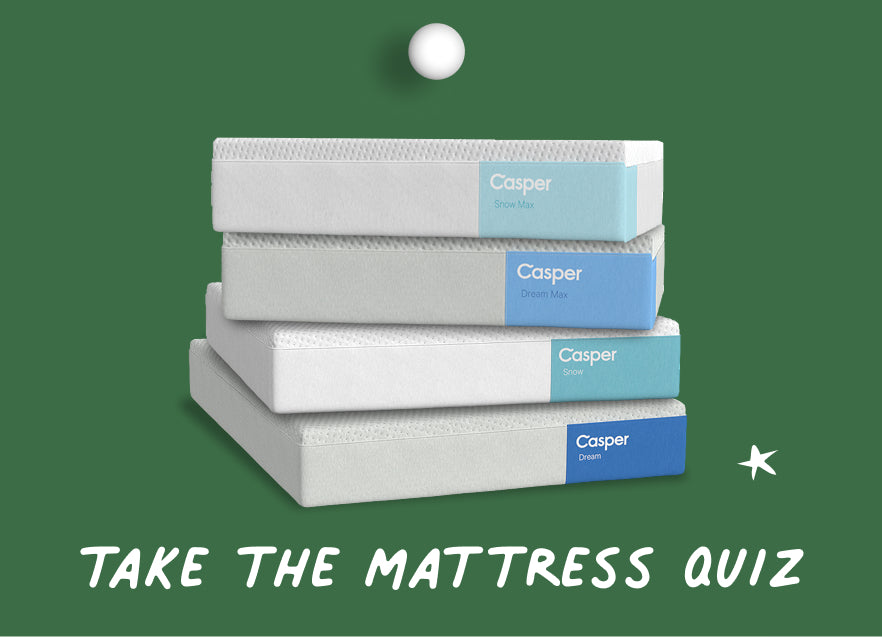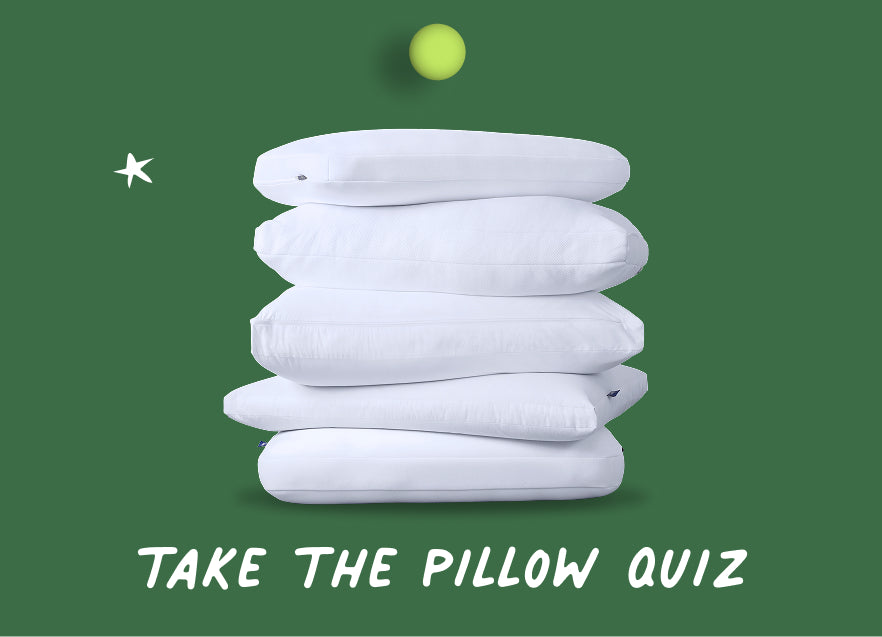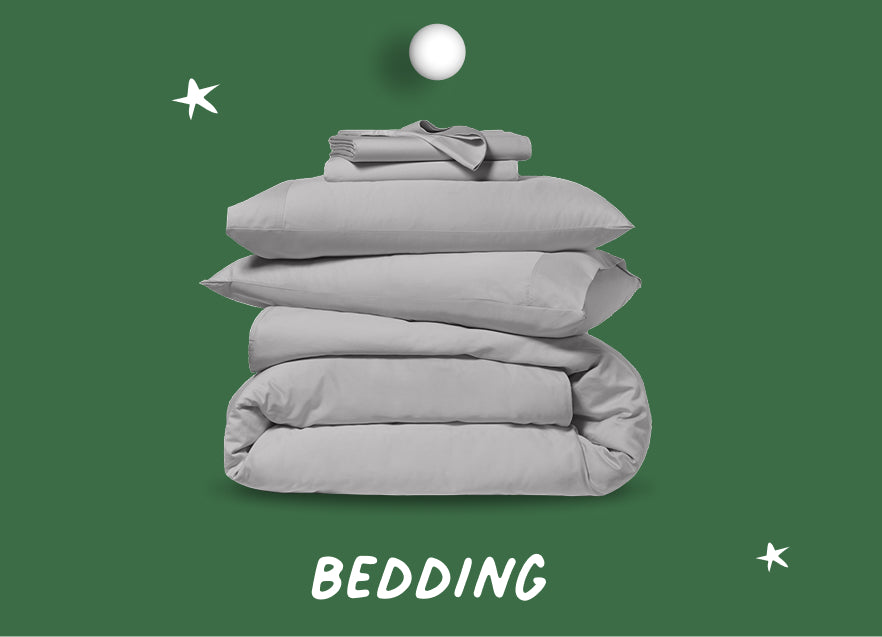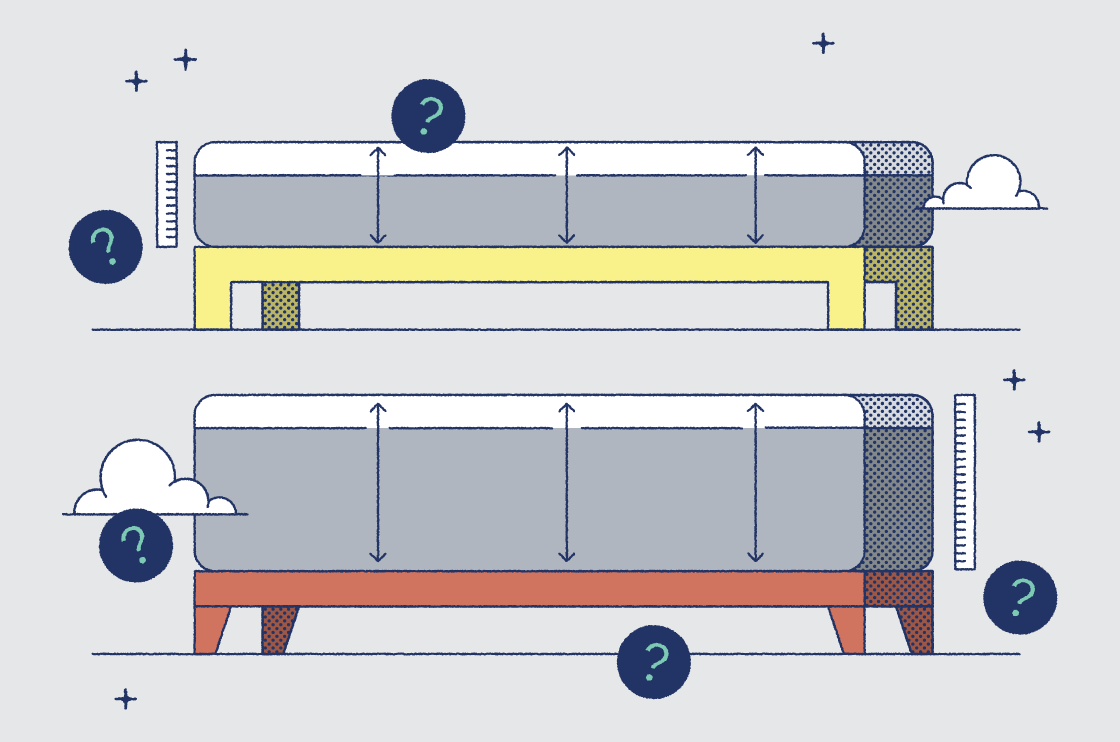Searching for the perfect mattress may make you feel like (a sleep-deprived) Goldilocks. You don’t want a mattress that’s too thin, which can strain your back and break down faster, but you aren’t sure how thick you want your mattress to be.
With over one-third of our lives spent in bed, the quality of your mattress, including its thickness, can play a key role in your overall health and happiness.1
That’s why we’re here to help.
In this mattress thickness guide, we’ll break down the various levels of mattress thickness to help you determine the best choice for you based on your unique sleep needs, including your sleeping position and body weight.
That way, once you’ve identified signs that you need a new mattress, you’re guaranteed to find a mattress that’s just right.
Casper has ergonomic support designed into the premium thickness of every mattress. Browse our luxurious mattresses for ultimate comfort and support throughout the night.
Mattress Thickness Chart

| Category | Height (in) | Mattress Type |
|---|---|---|
| Low profile | 2–5” | Fold-away beds and Air mattresses |
| Slim profile | 2–8” | Children’s beds and Crib mattresses |
| Standard profile | 8–12” | Average mattress style |
| Thick profile | 12–20” | Plus-sized mattresses |
| Extra thick profile | 20+” | Luxury mattresses |
When it comes to thickness, mattresses can be separated into five distinct categories:
- Low profile — These mattresses range between 2 and 5 inches in height.2 They’re usually seen in fold-away beds and air mattresses. If you have a low-profile bed and want a softer mattress, add a mattress topper for an additional layer of comfort.
- Slim profile — Between 2 and 8 inches, slim-profile mattresses are typically made of dense foam, providing support without adding excess mattress height. These mattresses are ideal for children and sleepers with limited mobility.
- Standard profile — These range in height between 8 and 12 inches. With a quality foundation of around 6 inches, this standard mattress height can provide an additional comfort layer.
In fact, the Casper Original Mattress falls into this category. It boasts 11 inches of polyurethane foam designed to ergonomically align your spine. It also allows air to circulate and keep you cool throughout the night when you’re tucked in between your bed sheets.
- Deep or thick profile — These mattresses are between 12 and 20 inches. The higher price point raises the mattress’s overall durability, making it an ideal choice for sleepers looking for optimal comfort and pressure relief.
The Casper Wave Hybrid Mattress is a perfect example of a thick-profile mattress. Its 13 inches of support consists of three layers of AirScape™ cooling foam, supportive gel pods, and resilient springs for additional lift and bounce.
- Extra thick profile — With thicknesses of 20 inches or more, an extra thick mattress can provide the most amount of comfort layer.2 Extra thick mattresses are the most expensive thickness option, and they’re also extremely heavy, making them difficult to ship and move.
How Thick Is a Mattress?

Mattresses are comprised of layers that, when combined, can range between 2 and 20 inches thick.2
These layers are divided into two categories:
Foundation or Base Layer
Like the foundation of your home, the base layer of your mattress is responsible for providing overall durability and support. Without a thick enough mattress foundation, a bed will show signs of wear and tear sooner, such as sagging in the areas where your hips and low back lie.
For optimal performance, your mattress foundation layer should be around 5 to 6 inches thick.2
Comfort Layers
The remaining layers of your mattress are comfort layers. These layers contribute to healthy spine alignment, pressure relief, and motion isolation. When these factors come together, they form a comfort trifecta — a team of sleep superheroes working to save you from nights of discomfort and restlessness.
However, if your comfort layers are too thin, you won’t receive the proper support to keep your spine in alignment and alleviate pressure from your lower back, shoulders, and hips, no matter your go-to sleeping position.
This may even prompt you to research how to fix a sagging mattress if indentations begin to form within the thin comfort layers of your bed.
Similarly, if your comfort layers are too thick, you may experience that oversized marshmallow sensation, which also isn’t ideal for the health and longevity of your spine (or your bed).
How To Choose Your Mattress Thickness
While understanding the categories of mattress thickness can narrow down your mattress search, identifying your unique sleep preferences and needs can help pinpoint the exact mattress of your dreams. When choosing a mattress thickness, you’ll want to consider a few factors.
Sleeping Position

Whether you like to sleep like a starfish atop a warm rock, or a cat curled up on its side, different sleeping positions can benefit from different mattress thicknesses.
Back sleepers:
- Ideal mattress height: 6 to 8 inches
- Support level: Back sleepers need support for shoulders and bottoms while maintaining spinal alignment.
Side sleepers:
- Ideal mattress height: 8 to 10 inches
- Support level: Side sleepers need support for hips, neck, and shoulders
Stomach sleepers:
- Ideal mattress height: 10 to 15 inches
- Support level: Stomach sleepers need support for lower back
Stomach sleeping can strain your neck and back3, however, making it difficult for any mattress thickness to support you properly.
Body Weight
Additional mattress thickness allows for greater amounts of weight to be evenly distributed over the mattress, which is essential for achieving spinal alignment and maximizing support. This is particularly beneficial to couples who need a mattress that can withstand the weight of two people rather than just one.
If you are a single sleeper, you may choose a more traditional 11-inch mattress. These mattresses can typically support the weight of one to two people comfortably, depending on size.
Bed Base
Aside from physical benefits, mattress thickness can also impact the feel and style of your bedroom. If you have a lower bed frame that captures a more Scandinavian look, a standard profile mattress, like the 10-inch Casper Element Mattress, can provide optimum support and durability without drawing too much attention to itself or adding too much height.
Similarly, if you have a tall bed frame, you probably want to forgo an extra thick mattress and avoid leaping into and out of your bed every day.
Casper Mattresses by Thickness
Each Casper mattress has key features that set them apart from one another — one being thickness. Learn more about some of our most popular Casper mattresses and what their level of thickness can offer you.
Standard Thickness: The Casper Original
- Both the Casper Original and Casper Original Hybrid are 11 inches thick, which is considered standard mattress height. These wallet-friendly options are great for sleepers who are looking for a boatload of comfort at prices that won’t break the bank.
Best for: Sleepers looking for comfort and support
Price (Queen)
Pros:
- Most affordable Casper mattresses
- Zoned Support™ ergonomically aligns your spine
- AirScape™ lets air circulate to keep you cool
- Premium foam conforms to your body to relieve pressure
- Durable base foam offers long-lasting support
Cons:
- May not be thick enough for couples to sleep comfortably
- May not be plush enough for those with specialized sleeping needs
Affordable Luxury: The Casper Nova Hybrid
- The Casper Nova Hybrid is 12 inches thick, which sits between a standard and thick mattress height. This mattress is a great option for those looking for sturdy support and a touch of luxury.
Best for: Sleepers who require lumbar support
Price (Queen)
- Casper Nova Hybrid: $2,295
Pros:
- Luxurious soft top layer comforts you to sleep
- AirScape™ 2 helps prevent overheating
- Zoned Support™ Pro helps align your spine
- Resilient springs prevent sinking and add lift and airflow
- Designed to let your back muscles rest and sleep in alignment
- Designed to give you the support your body needs
Cons:
- More expensive Casper mattress
Ultra Luxury: The Casper Wave Hybrid
- The Casper Wave Hybrid is 13 inches thick, which is a bit thicker than the standard mattress height. If you’re looking to indulge in a higher-quality mattress, you may find the Wave Hybrid is your perfect fit.
Best for: Sleepers who require back support and comfort
Price (Queen)
Pros:
- Zoned Support™ Max and gel pods ergonomically align your spine in two layers with gel pod support that cradle your hips
- AirScape™ 3 and cooling gel circulates air away from you and keeps your mattress cool to the touch
- Uses hundreds of resilient springs to add lift, airflow, and a bit of bounce
- Cradling top foams help you fall asleep faster
Cons:
- Most expensive Casper mattress
- Heavy to move
FAQ
The average thickness of a mattress is 10 inches and is considered a standard mattress thickness.2 Most sleepers can be comfortable with this mattress thickness.
A suitable mattress should have a base layer of 6 to 8 inches and a comfort layer of 2 to 3 inches. A 10-inch vs. 12-inch mattress can be a significant difference, so investigate how much extra cushion you need before purchasing.
The average bed height is approximately 25 inches from the ground. You can find your bed’s current height by measuring from the floor to the top of your mattress.
Using a mattress topper can add an extra layer of thickness and comfort to your bed. It’s an affordable way to add some thickness to your bed if you’re not ready to purchase a new mattress.
A memory foam mattress should be 10 to 14 inches thick. A thinner mattress is more prone to sagging over time and may not provide as much cushiony comfort as thicker memory foam. A high-quality memory foam mattress can last you eight to 12 years if taken care of correctly.
The thickness of a base layer can affect how long your mattress lasts. Mattresses with pocket coils can last five to eight years, whereas memory foam can last eight to 12 years. These estimates will depend on the number of coils or memory foam thickness. For maximum durability, your base layer should be at least 50% of the bed height.
A 2-inch mattress topper can do just the trick to either soften or firm up your mattress, depending on what you need. Mattress toppers range from 2 to 4 inches thick.
Mattresses taller than 14 inches may require a larger sheet size. Adding a mattress pad or topper may also require a larger size sheet.
For a Mattress Thickness Right for You, Choose Casper
No matter whether you’re in the market for a softer mattress or a more firm mattress, with a Casper mattress, you can cozy up to pressure point relief, ideal spinal alignment, and long-lasting durability to achieve the sleep you’ve been dreaming of.
We’re sure you’ll find the mattress that’s just right for your individual sleep needs. To make the most out of your sleep and find the mattress that’s just right for you, choose Casper.
Sources:
Harvard Health Publishing. How much sleep do we really need? https://www.health.harvard.edu/staying-healthy/how-much-sleep-do-we-really-need
Sleep Report. Mattress Thickness, Does Depth Matter? Which Is Best? https://sleep.report/mattress-thickness/
Healthline. Is It Bad to Sleep on Your Stomach? https://www.healthline.com/health/is-it-bad-to-sleep-on-your-stomach












